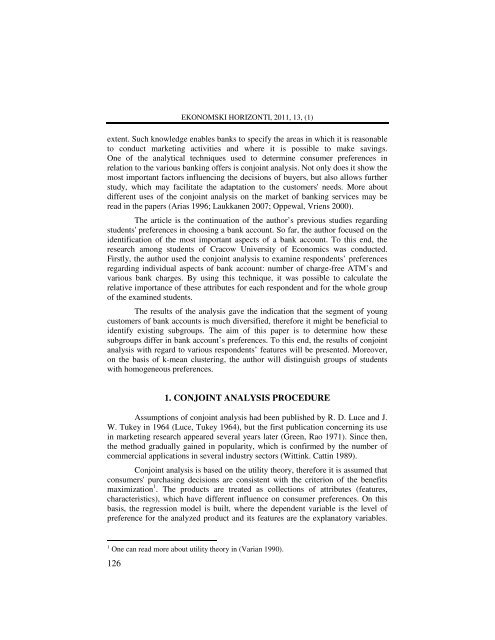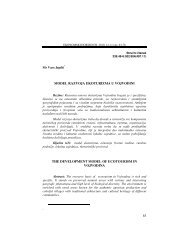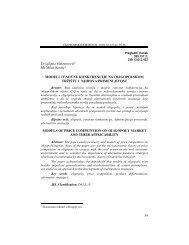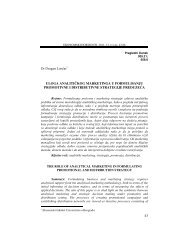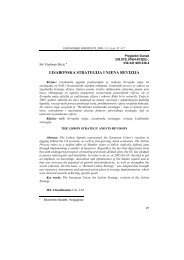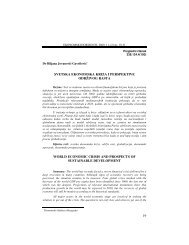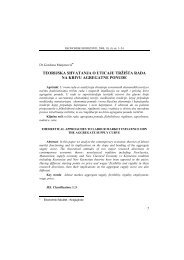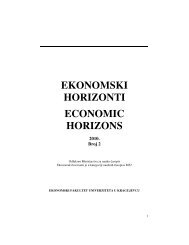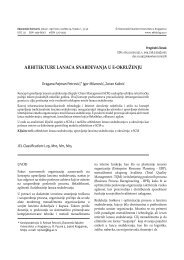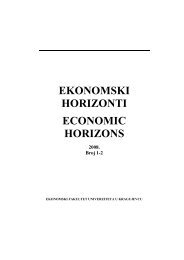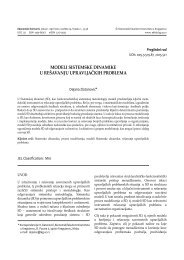yu issn 1450-863 x godina xiii broj 1 / 2011. - horizonti.ekfak.kg.ac.rs
yu issn 1450-863 x godina xiii broj 1 / 2011. - horizonti.ekfak.kg.ac.rs
yu issn 1450-863 x godina xiii broj 1 / 2011. - horizonti.ekfak.kg.ac.rs
You also want an ePaper? Increase the reach of your titles
YUMPU automatically turns print PDFs into web optimized ePapers that Google loves.
EKONOMSKI HORIZONTI, 2011, 13, (1)<br />
extent. Such knowledge enables banks to specify the areas in which it is reasonable<br />
to conduct marketing <strong>ac</strong>tivities and where it is possible to make savings.<br />
One of the analytical techniques used to determine consumer preferences in<br />
relation to the various banking offe<strong>rs</strong> is conjoint analysis. Not only does it show the<br />
most important f<strong>ac</strong>to<strong>rs</strong> influencing the decisions of buye<strong>rs</strong>, but also allows further<br />
study, which may f<strong>ac</strong>ilitate the adaptation to the custome<strong>rs</strong>' needs. More about<br />
different uses of the conjoint analysis on the market of banking services may be<br />
read in the pape<strong>rs</strong> (Arias 1996; Laukkanen 2007; Oppewal, Vriens 2000).<br />
The article is the continuation of the author’s previous studies regarding<br />
students' preferences in choosing a bank <strong>ac</strong>count. So far, the author focused on the<br />
identification of the most important aspects of a bank <strong>ac</strong>count. To this end, the<br />
research among students of Cr<strong>ac</strong>ow Unive<strong>rs</strong>ity of Economics was conducted.<br />
Fi<strong>rs</strong>tly, the author used the conjoint analysis to examine respondents’ preferences<br />
regarding individual aspects of bank <strong>ac</strong>count: number of charge-free ATM’s and<br />
various bank charges. By using this technique, it was possible to calculate the<br />
relative importance of these attributes for e<strong>ac</strong>h respondent and for the whole group<br />
of the examined students.<br />
The results of the analysis gave the indication that the segment of young<br />
custome<strong>rs</strong> of bank <strong>ac</strong>counts is much dive<strong>rs</strong>ified, therefore it might be beneficial to<br />
identify existing subgroups. The aim of this paper is to determine how these<br />
subgroups differ in bank <strong>ac</strong>count’s preferences. To this end, the results of conjoint<br />
analysis with regard to various respondents’ features will be presented. Moreover,<br />
on the basis of k-mean clustering, the author will distinguish groups of students<br />
with homogeneous preferences.<br />
1. CONJOINT ANALYSIS PROCEDURE<br />
Assumptions of conjoint analysis had been published by R. D. Luce and J.<br />
W. Tukey in 1964 (Luce, Tukey 1964), but the fi<strong>rs</strong>t publication concerning its use<br />
in marketing research appeared several yea<strong>rs</strong> later (Green, Rao 1971). Since then,<br />
the method gradually gained in popularity, which is confirmed by the number of<br />
commercial applications in several industry secto<strong>rs</strong> (Wittink. Cattin 1989).<br />
Conjoint analysis is based on the utility theory, therefore it is assumed that<br />
consume<strong>rs</strong>' purchasing decisions are consistent with the criterion of the benefits<br />
maximization 1 . The products are treated as collections of attributes (features,<br />
char<strong>ac</strong>teristics), which have different influence on consumer preferences. On this<br />
basis, the regression model is built, where the dependent variable is the level of<br />
preference for the analyzed product and its features are the explanatory variables.<br />
1<br />
One can read more about utility theory in (Varian 1990).<br />
126


